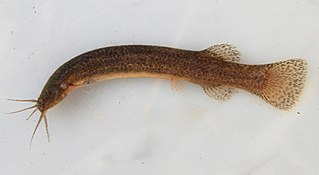
Trichomycteridae is a family of catfishes commonly known as pencil catfishes or parasitic catfishes. This family includes the candiru fish, feared by some people for its alleged habit of entering into the urethra of humans. They are one of the few parasitic chordates. Another species is the life monsefuano which was important to the Moche culture and still an important part of Peruvian cuisine.

The Cetopsidae are a small family of catfishes, commonly called the whale catfishes.

The Aspredinidae are a small South American family of catfishes also known as the banjo catfishes, with about 43 species.
Listrura is a genus of pencil catfishes native to South America.

Trichomycterus is a genus of fish in the family Trichomycteridae, the largest genus of its family with over 170 species currently described. This genus is native to freshwater habitats in Central and South America. These fish are generally small, usually about 5 to 15 cm (2–6 in) in standard length, although the largest, T. rivulatus, can reach more than twice this size. Species differ from one another primarily in body proportions, fin ray counts and colouration. Despite their relatively small size, some, such as T. punctulatus, support fisheries and are important in the local cuisine.

Phreatobius is a genus of very small catfishes from tropical South America.
Malacoglanis gelatinosus is a species of catfish of the family Trichomycteridae, and the only species of the genus Malacoglanis. This fish grows to about 2.0 centimetres (.79 in) SL. and is native to the Caquetá River basin of Colombia. Stauroglanis is the sister group to a monophyletic group formed by Malacoglanis and Sarcoglanis.
Sarcoglanis simplex is a species of catfish of the family Trichomycteridae, and the only species of the genus Sarcoglanis. This fish originates from the upper Rio Negro basin of Brazil. Stauroglanis is the sister group to a monophyletic group formed by Malacoglanis and Sarcoglanis.
Stauroglanis gouldingi is a species of catfish of the family Trichomycteridae, and the only species of the genus Stauroglanis.
Ammoglanis is a genus of pencil catfishes native to South America.
Microcambeva is a genus of catfishes of the family Trichomycteridae.
Glanapteryx is a genus of catfishes native to South America.
Pygidianops is a genus of pencil catfishes native to South America.
Typhlobelus is a genus of pencil catfishes native to South America.
The Sarcoglanidinae are a subfamily of catfishes of the family Trichomycteridae. It includes six genera: Ammoglanis, Malacoglanis, Microcambeva, Sarcoglanis, Stauroglanis, and Stenolicmus.

Ituglanis is a genus of small freshwater fish in the family Trichomycteridae native to South America. Their greatest diversity seems to occur in the Amazon River basin. Most species inhabit leaf litter, with several species living in caves.

The Trichomycterinae are a subfamily of catfishes of the family Trichomycteridae. It includes six genera, Bullockia, Hatcheria, Rhizosomichthys, and Eremophilus, all monotypic, Silvinichthys with seven species, and Trichomycterus, with over 170 species. The former five genera are diagnosed by putatively apomorphic characters, whereas Trichomycterus is defined by the lack of those specializations and is likely not monophyletic. This subfamily has historically served as much of a wastebasket for trichomycterids that lack the specializations of the other subfamilies. Species of Trichomycterinae dwell in headwaters and small, cold clear water streams running over stony beds. Due to the patchy distribution of their habitats, trichomycterines generally have restricted geographic distributions, thus display a high level of endemism.

Cetopsis is a genus of catfishes of the family Cetopsidae.
The Copionodontinae are a subfamily of catfishes of the family Trichomycteridae. It includes two genera, Copionodon and Glaphyropoma.
Stenolicmus ix is a species of catfish in the family Trichomycteridae- also called the Pencil or Parasitic Catfishes. It was described from the Curuá River, in the Brazilian state of Pará, which is part of the Amazon River basin.







